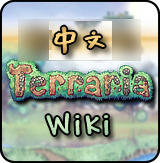可再生资源的反面就是不可再生资源——那些可能常见或不常见但无法在单独的世界中被创造的物品。
不可再生的物品包括:
- 伴随着世界一同生成的一些方块,它们也许很丰富,但却无法被制造或者用其他的方式创造出来。特别地,这适用于大部分的土壤类型方块,以及蜂王和与其相关的物品。这些不可再生方块通常仅会在玩家探索完整个世界并决定彻底重建它的时候才会成为一个问题。
- 一些在特定的宝箱中发现的物品,这些宝箱在一个世界中只会生成有限个,其中一些也无法通过钓鱼获得。大部分宝箱本身就是不可再生的。
- 一些在特定的位置生成的物品,并且无法被用其他的方式创造出来。这包括了来自于一些固定建筑的家具和材料,尤其是地牢,丛林神庙,地狱里的废墟建筑,以及祭坛。这些建筑通常会包含一些上面提到的生成在特定位置的宝箱。
- 一些天然的墙,它们无法被玩家采集或者制造。在一些情况下,这通常与游戏机制和/或游戏平衡有关。
- 任何在制作配方中需要用到不可再生物品的物品。
- 大部分NPC的任务奖励是可再生的,但也有一些例外:绒毛胡萝卜和渔夫盔甲套只能获取一次,所以每个玩家在单个世界中只能获得一个这样的物品。
显然,任何可以被购买,从掉落中获得,或者通过可再生材料制作得到的物品,一定是可再生的。
不可再生的物品很少,以至于可以单独列出。其中有一小部分是“半可再生的”,也就是可以由那些大量但是有限的物品产生的物品。
Plentiful but finite
- The various Soil types are created with the world, but only Sand and Granite (and sometimes Snow) can actually be created in-world. Ignoring variations of grass, moss, and biome conversion, that leaves Dirt, Stone, Clay, Mud, Silt, Slush, Desert Fossil, Hardened Sand, Sandstone, Ice, Thin Ice, Ash, and Marble as plentiful but non-renewable. This extends to items created from the above materials, including:
- All craftable Statues
- Several furniture sets: Frozen, Marble, Flesh, and (due to the stone needed for their bricks) Skyware, Meteorite, and Crystal.
- Most brick types, as they tend to include stone or other non-renewable blocks. Exceptions .are Sandstone Brick, Snow Brick, and Rainbow Brick.
- Gems are found placed in the world, but the only other source for them is using an Extractinator on Silt, Slush, and Desert Fossils. Therefore gems (including Amber), are non-renewable, as is the Amber Mosquito item. Note that it is possible to deplete a world's Extractinator blocks, especially in a small world.
- Hive blocks are found only in hives in the Jungle. Since Hive (or a Larva, which is only generated with the world) is needed to summon the Queen Bee, this makes the Queen Bee's drops (except Bottled Honey), and any item made with Bee Wax (Bee armor, Beenade, Hornet Staff), plentiful but non-renewable.
- Some types of natural Wall cannot be harvested or crafted by the player; even harvestable walls will no longer be considered "natural" if they are harvested and replaced.
- Natural walls do not suppress enemy spawning, while any placed walls can.
- The Dungeon, Spider Cave, and Underground Desert (mini-)biomes are defined by the presence of their respective naturally generated walls.
- Chlorophyte Ore is created by replacing mud, which can be crafted from dirt, but is still technically non-renewable. In practice this makes chlorophyte "nearly unlimited", but it would conceivably be possible to deplete a world's mud/dirt. This likewise applies to Shroomite and Spectre Bars, which are made from chlorophyte. For tips on "farming" chlorophyte, see Guide:Farming Resources.
- Hellstone is arguably plentiful, but still finite.
Location Specific Generation
A few items are created with the world in particular locations, and cannot otherwise be created in world. This includes (but is not limited to) furnishings and materials from several fixed structures, notably the Dungeon, the Jungle Temple, the Underworld's Ruined Houses. It also covers most of the special chests from these structures, and most Trap blocks.
- Varied Locations:
- Sky Islands:
- Cloud blocks (including rain and snow cloud).
- Underground and Caverns:
- Geyser Traps
- Dart Traps
- Non-craftable Statues
- Sharpening Station
- Jungle Temple:
- Lihzahrd Bricks, and all matching furniture and statues
- Lihzahrd Pressure Plates and traps: Spiky Ball Trap, Flame Trap, Spear Trap, Super Dart Trap, Wooden Spike
- Lihzahrd Chest
- Lihzahrd Altar
- Dungeon:
- Dungeon Bricks and most associated Furniture.
- Alchemy Table
- Water Bolt
- Bone Welder (placed or in chests)
- Valor (yo-yo) (in chests)
- Catacomb
- Underworld:
- Obsidian Furniture (the few craftable pieces require hellstone ore, except platforms)
- Hellforge
- Hellstone ore
- see also "Shadow Chests" below.
Location-Specific Chests
Various special chests spawn with a world, and even those chests which have corresponding Crates have a few items which are not found in in the crates. In all cases, items are listed under only the first chest they appear in. All of the chests listed below are themselves uncraftable and non-renewable items. Some of these chests are common enough to qualify as "plentiful", but random chance can still fail to supply one of their items in a given world.
In general, the non-renewability of these items extends to items crafted from them; the notable exception is Hermes and Flurry boots., whose upgrades can all be crafted with Sailfish boots.
- Gold Chest (most items are shared with naturally generated Wooden chests):
- Spear
- Wooden Boomerang
- Enchanted Boomerang
- Blowpipe
- Umbrella
- Wand of Sparking
- Herb Bag (the herbs and seeds it contains are renewable)
- Band of Regeneration
- Magic Mirror
- Cloud in a Bottle
- Hermes Boots (but renewable Sailfish boots are identical)
- Shoe Spikes
- Flare Gun
- Lava Charm
- Gold Chests in Pyramid:
- Ice Chest
- Ice Boomerang
- Ice Blade
- Ice Skates
- Snowball Cannon
- Blizzard in a Bottle
- Flurry Boots (but renewable Sailfish boots are identical)
- Ice Machine
- Ice Mirror (identical to Magic Mirror)
- Fish (item)
- Ivy Chest
- Living Wood Chest
- Skyware Chest
- Water Chest
- Web Covered Chest
- Shadow Chest
- the four-out-of-five Biome Chests in the Dungeon: Frozen, Jungle, Hallowed, and either Corruption or Crimson.
- Their special prizes are likewise non-renewable: Staff of the Frost Hydra, Piranha Gun, Rainbow Gun, Scourge of the Corruptor, and Vampire Knives.
Non-renewable Crafting Stations
It seems worthwhile to summarize those crafting stations which are non-renewable (as listed above). Special mention for the Sharpening Station, which is not a crafting station but in some ways resembles one.
- Furnace (but "plentiful" like the stone it is made of)
- Alchemy Table
- Bone Welder
- Hellforge (And thus, the Hardmode Forges)
- Honey Dispenser
- Ice Machine
- Lihzahrd Furnace
- Living Loom
- Sky Mill
